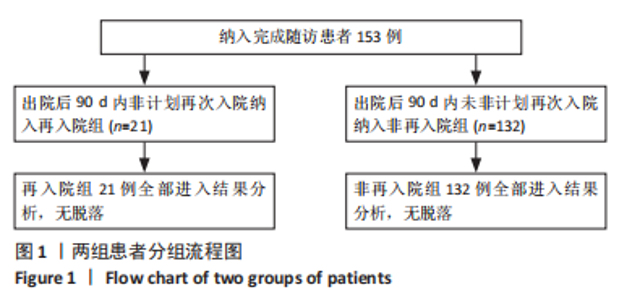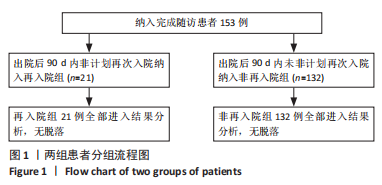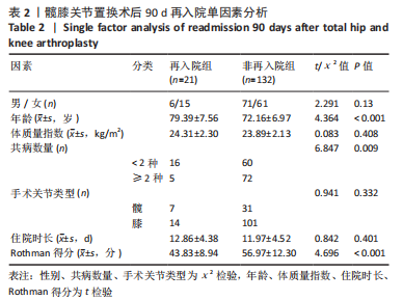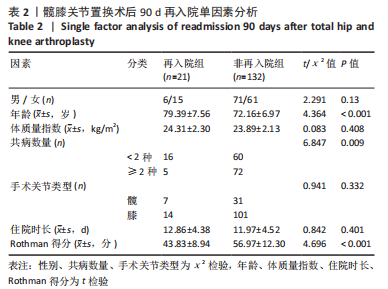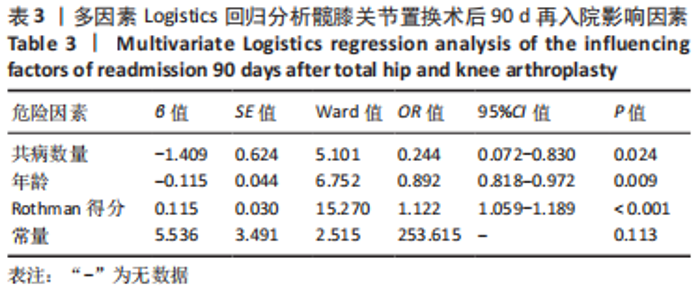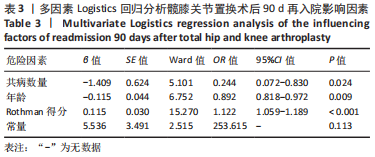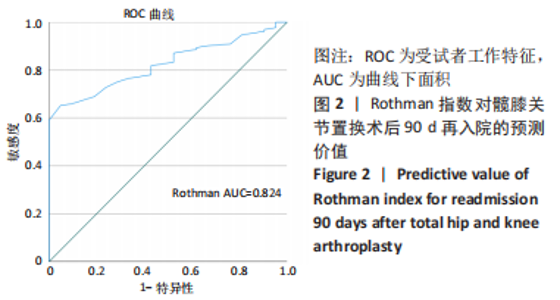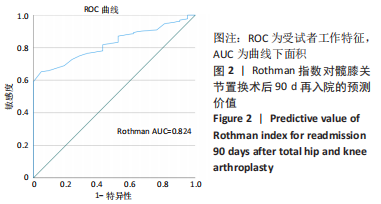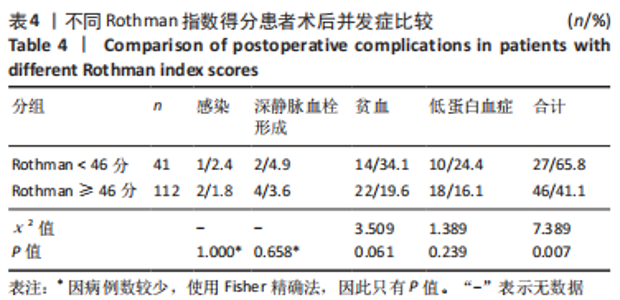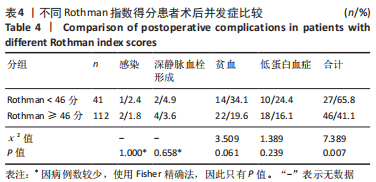[1] GINNETTI JG, O’CONNOR MI, CHEN AF, et al. Total Joint Arthroplasty Training (Prehabilitation and Rehabilitation) in Lower Extremity Arthroplasty. J Am Acad Orthop Surg. 2022;30(11): e799-e807.
[2] MARTINA K, HUNTER DJ, SALMON LJ, et al. Surgery for Osteoarthritis: Total Joint Arthroplasty, Realistic Expectations of Rehabilitation and Surgical Outcomes: A Narrative Review. Clin Geriatr Med. 2022;38(2): 385-396.
[3] KIM H, KIM CH. Association Between Preoperative Depression and Readmission Rate Following Primary Total Joint Arthroplasty: A Systematic Review and Meta-Analysis. J Arthroplasty. 2021;36(11): 3807-3813.
[4] LYGRISSE KA, ZAK S, SINGH V, et al. Emergency Department Observation Versus Readmission Following total Joint Arthroplasty: Can We Avoid the Bundle Buster? J Arthroplasty. 2021;36(3):833-836.
[5] OEDING JF, BOSCO JA 3rd, CARMODY M,et al. RAPT Scores Predict Inpatient Versus Outpatient Status and Readmission Rates After IPO Changes for Total Joint Arthroplasty: An Analysis of 12,348 Cases. J Arthroplasty. 2022;37(11):2140-2148.
[6] KATAKAM A, COHEN-LEVY W, HOSSEINZADEH S, et al. One-Year Readmissions Following Total Joint Arthroplasty May Be Associated With Failure to Achieve the Minimal Clinically Important Difference of Patient-Reported Outcomes Measurement Information System Physical, Mental, and Physical-Short Form-10a. Cureus. 2022;14(12):e32181.
[7] 杜昆伦,白希壮.人工全关节置换术后非计划再次入院的原因、危险因素及预防分析[J].实用骨科杂志,2019,25(8):681-685.
[8] KIRKLAND PA, BARFIELD WR, DEMOS HA, et al. Optimal Length of Stay Following Total Joint Arthroplasty to Reduce Readmission Rates. J Arthroplasty. 2020;35(2):303-308.
[9] GOTUR DB, MASUD F, PARANILAM J, et al. Analysis of Rothman Index Data to Predict Postdischarge Adverse Events in a Medical Intensive Care Unit. J Intensive Care Med. 2020;5(6):606-610.
[10] MOGUILLANSYK D, SHARAF OM, JIN P, et al. Evaluation of Clinical Predictors for Major Outcomes in Patients Hospitalized With COVID-19: The Potential Role of the Rothman Index. Cureus. 2022;14(9):e28769.
[11] ROTHMAN MJ, ROTHMAN SI, BEALS J 4th. Development and validation of a continuous measure of patient condition using the Electronic Medical Record. J Biomed Inform. 2013;46(5):837-48.
[12] 胡孔足.关节置换术住院时间短不会增加90 d内再入院风险[J].临床骨科杂志,2023,26(2):246.
[13] SWIGGETT SJ, MANNINO A, VAKHARIA RM, et al. Impact of Biological Sex on Complications, Lengths of Stay, Readmission Rates, and Costs of Care Following Primary Total Knee Arthroplasty. J Knee Surg. 2022; 35(12):1306-1311.
[14] 刘子歌,张晨,宋国瑞,等.磨损颗粒在人工关节置换术后无菌性松动中的作用机制及其影响因素[J].中国骨科临床与基础研究杂志,2020,12(3):177-184.
[15] 曾泓凯,张亚丽,崔文,等.用于全关节置换术的聚合物研究进展[J].塑料工业,2019,47(6):1-7+13.
[16] 杨辉,王文革,李仕臣,等.单髁关节置换术治疗创伤性膝关节炎临床效果观察[J].临床军医杂志,2022,50(9):942-944.
[17] 翁习生.拥抱机器人辅助关节置换手术新时代[J].中华骨与关节外科杂志,2022,15(8):561-562.
[18] 柴伟.关节外科机器人的现状与思考[J].中华骨与关节外科杂志, 2022,15(8):563-568.
[19] 单鹏程,胡佩岩,何名江,等.人工髌股关节置换术的早中期随访研究[J].中华骨科杂志,2022,42(13):831-838.
[20] 谢泰安.关节置换术治疗老年膝关节退行性骨关节炎的临床疗效探讨[J].中国全科医学,2021,24(S2):135-137.
[21] 宋丹丹,戴俊,夏玉萍,等.核心肌锻炼在高龄髋部骨折关节置换术的作用[J].中国矫形外科杂志,2020,28(16):1459-1462.
[22] 昌敬惠,范悦,王冬.人工关节置换术患者住院总费用及结构分析[J].中国卫生经济,2020,39(12):69-72.
[23] WORKMAN KK, ANGERETT N, LIPPE R, et al. Thirty-Day Unplanned Readmission after Total Knee Arthroplasty at a Teaching Community Hospital: Rates, Reasons, and Risk Factors. J Knee Surg. 2020;33(2): 206-212.
[24] PHRUETTHIPHAT OA, OTERO JE, ZAMPOGNA B, et al. Predictors for readmission following primary total hip and total knee arthroplasty. J Orthop Surg (Hong Kong). 2020;28(3):1-10.
[25] ROGER C, DEBUYZER E, DEHL M, et al. Factors associated with hospital stay length, discharge destination, and 30-day readmission rate after primary hip or knee arthroplasty: Retrospective Cohort Study. Orthop Traumatol Surg Res. 2019;105(5):949-955.
[26] GOULD D, DOWSEY M, JO I, et al. Patient-related risk factors for unplanned 30-day readmission following total knee arthroplasty: a narrative literature review. ANZ J Surg. 2020;90(7-8):1253-1258.
[27] SINGH V, ANIL U, KURAPATTI M, et al. Emergency department visits following total joint arthroplasty: do revisions present a higher burden? Bone Jt Open. 2022;(7):543-548.
[28] MCLYNN RP, OTTESEN TD, ONDECK NT, et al. The Rothman Index Is Associated With Postdischarge Adverse Events After Hip Fracture Surgery in Geriatric Patients. Clin Orthop Relat Res. 2018;476(5):997-1006.
[29] MCLYNN RP, ONDECK NT, CUI JJ, et al. The Rothman Index as a predictor of postdischarge adverse events after elective spine surgery. Spine J. 2018;18(7):1149-1156.
[30] KLEVEN AD, MIDDLETON AH, KESIMOGLU ZN, et al. Do In-Hospital Rothman Index Scores Predict Postdischarge Adverse Events and Discharge Location After Total Knee Arthroplasty? J Arthroplasty. 2022;37(4):668-673.
|
